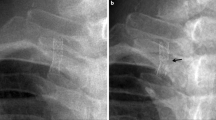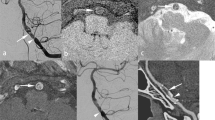Abstract
Purpose
This study was designed to present the treatment outcomes with Wingspan stent angioplasty of high-grade intracranial vertebrobasilar artery (VBA) stenosis in symptomatic patients.
Methods
Between 2007 and 2010, the records of 30 patients with 31 intracranial high-grade VBA stenoses (all≥70%) who underwent elective stenting due to the failure of medical therapy were retrospectively reviewed. Clinical evaluation was performed based on the modified Rankin scale and the National Institutes of Health Stroke Scale.
Results
In all cases, the stent deployment was technically successful. The mean stenosis decreased significantly from 82.28 ± 8.02% (range, 72–99%) to 11.18 ± 7.28% (range, 0–25%) after stent-assisted angioplasty (P < 0.05). Periprocedure complications occurred in 3 (10%) of 30 patients; there were 2 cases of perforator strokes and 1 case of transient flow insufficiency with stent overlap. Clinical follow-up (mean, 17.81 ± 11.49 months; range, 5–40 months) was available for 27 patients, and angiographic follow-up (mean, 9.95 ± 5.74 months, range, 5–20 months) was available for 19 patients. Only one case demonstrated recurrent symptoms with restenosis (≥50%). There were no recurrent ischemic events and no cases of restenosis in the other patients.
Conclusions
According to our data, the Wingspan stent for symptomatic intracranial VBA stenoses is a safe and efficacious treatment alternative in cases with recurrent symptoms despite medical therapy. However, the improvement of outcome requires the reduction in the rate of procedure-related complications and long-term outcomes still have to be demonstrated.


Similar content being viewed by others
References
Wityk RJ, Lehman D, Klag M et al (1996) Race and sex differences in the distribution of cerebral atherosclerosis. Stroke 27(11):1974–1980
Sacco RL, Kargman DE, Gu Q et al (1995) Race-ethnicity and determinants of intracranial atherosclerotic cerebral infarction the Northern Manhattan Stroke study. Stroke 26(1):14–20
Feldmann E, Daneault N, Kwan E et al (1990) Chinese-white differences in the distribution of occlusive cerebrovascular disease. Neurology 40(10):1541–1545
Qureshi AI, Ziai WC, Yahia AM et al (2003) Stroke-free survival and its determinants in patients with symptomatic vertebrobasilar stenosis: a multicenter study. Neurosurgery 52(5):1033–1039
Hopkins LN, Budny JL (1989) Complications of intracranial bypass for vertebrobasilar insufficiency. J Neurosurg 70(2):207–211
Kieffer E, Praquin B, Chiche L et al (2002) Distal vertebral artery reconstruction: long-term outcome. J Vasc Surg 36(3):549–554
Sacco RL, Adams R, Albers G, et al (2006) American Heart Association/American Stroke Association Council on Stroke; Council on Cardiovascular Radiology and Intervention; American Academy of Neurology Guidelines for prevention of stroke in patients with ischemic stroke or transient ischemic attack: a statement for healthcare professionals from the American Heart Association/American Stroke Association Council on Stroke: co-sponsored by the Council on Cardiovascular Radiology and Intervention: the American Academy of Neurology affirms the value of this guideline. Circulation 113(10):e409–444
The Warfarin-Aspirin Symptomatic Intracranial Disease (WASID) Study Group (1998) Prognosis of patients with symptomatic vertebral or basilar artery stenosis. Stroke 29(7):1389–1392
Chimowitz MI, Lynn MJ, Howlett-Smith H et al (2005) Warfarin–Aspirin symptomatic intracranial disease trial investigators comparison of warfarin and aspirin for symptomatic intracranial arterial stenosis. N Engl J Med 352(13):1305–1316
Levy EI, Horowitz MB, Koebbe CJ et al (2001) Transluminal stent-assisted angioplasty of the intracranial vertebrobasilar system for medically refractory, posterior circulation ischemia: early results. Neurosurgery 48(6):1215–1221
Levy EI, Hanel RA, Boulos AS et al (2003) Comparison of periprocedure complications resulting from direct stent placement compared with those due to conventional and staged stent placement in the basilar artery. J Neurosurg 99(4):653–660
Weber W, Mayer TE, Henkes H et al (2005) Stent-angioplasty of intracranial vertebral and basilar artery stenoses in symptomatic patients. Eur J Radiol 55(2):231–236
Kim DJ, Lee BH, Kim DI et al (2005) Stent-assisted angioplasty of symptomatic intracranial vertebrobasilar artery stenosis: feasibility and follow-up results. Am J Neuroradiol 26(6):1381–1388
Abruzzo TA, Tong FC, Waldrop AS et al (2007) Basilar artery angioplasty for symptomatic intracranial athero-occlusive disease: complications and late midterm clinical outcomes. Am J Neuroradiol 28(5):808–815
SSYLVIA Study Investigators (2004) Stenting of symptomatic atherosclerotic lesions in the vertebral or intracranial arteries (SSYLVIA): study results. Stroke 35(6):1388–1392
Henkes H, Miloslavski E, Lowens S et al (2005) Treatment of intracranial atherosclerotic stenoses with balloon dilatation and self-expanding stent deployment (WingSpan). Neuroradiology 47(3):222–228
Fiorella D, Levy EI, Turk AS et al (2007) US multicenter experience with the wingspan stent system for the treatment of intracranial atheromatous disease: periprocedural results. Stroke 38(3):881–887
Bose A, Hartmann M, Henkes H et al (2007) A novel, self-expanding, nitinol stent in medically refractory intracranial atherosclerotic stenoses: the Wingspan study. Stroke 38(5):1517–1531
Levy EI, Turk AS, Albuquerque FC et al (2007) Wingspan in-stent restenosis and thrombosis: incidence, clinical presentation, and management. Neurosurgery 61(3):644–650
Zaidat OO, Klucznik R, Alexander MJ et al (2008) NIH multi-center wingspan intracranial stent registry study group the NIH registry on use of the Wingspan stent for symptomatic 70–99% intracranial arterial stenosis. Neurology 70(17):1518–1524
Samuels OB, Joseph GJ, Lynn MJ et al (2000) A standardized method for measuring intracranial arterial stenosis. Am J Neuroradiol 21(4):643–646
Kasner SE, Chimowitz MI, Lynn MJ, Howlett-Smith H et al (2006) Warfarin aspirin symptomatic intracranial disease trial investigators predictors of ischemic stroke in the territory of a symptomatic intracranial arterial stenosis. Circulation 113(4):555–563
Turan TN, Maidan L, Cotsonis G et al (2009) Warfarin–aspirin symptomatic intracranial disease investigators. Failure of antithrombotic therapy and risk of stroke in patients with symptomatic intracranial stenosis. Stroke 40(2):505–509
Thijs VN, Albers GW (2000) Symptomatic intracranial atherosclerosis: outcome of patients who fail antithrombotic therapy. Neurology 55(4):490–497
de Rochemont Rdu M, Turowski B, Buchkremer M et al (2004) Recurrent symptomatic high-grade intracranial stenoses: safety and efficacy of undersized stents-initial experience. Radiology 231(1):45–49
Chow MM, Masaryk TJ, Woo HH et al (2005) Stent-assisted angioplasty of intracranial vertebrobasilar atherosclerosis: midterm analysis of clinical and radiologic predictors of neurological morbidity and mortality. Am J Neuroradiol 26(4):869–874
Cruz-Flores S, Diamond AL (2006) Angioplasty for intracranial artery stenosis. Cochrane Database Syst Rev 3:CD004133
Nahab F, Lynn MJ, Kasner SE et al (2009) NIH multicenter Wingspan intracranial stent registry study group. Risk factors associated with major cerebrovascular complications after intracranial stenting. Neurology 72(23):2014–2019
Groschel K, Schnaudigel S, Pilgram SM et al (2009) A systematic review on outcome after stenting for intracranial atherosclerosis. Stroke 40(5):e340–e347
Gupta R, Schumacher HC, Mangla S et al (2003) Urgent endovascular revascularization for symptomatic intracranial atherosclerotic stenosis. Neurology 61(12):1729–1735
Suh DC, Kim JK, Choi JW et al (2008) Intracranial stenting of severe symptomatic intracranial stenosis: results of 100 consecutive patients. Am J Neuroradiol 29(3):5781–5785
Masuo O, Terada T, Walker G et al (2005) Patency of perforating arteries after stent placement? A study using an in vivo experimental atherosolerosis-indused model. Am J Neuroradiol 26(3):543–548
Poerner TC, Kralev S, Voelker W et al (2002) Natural history of small and medium-sized side branches after coronary stent implantation. Am Heart J 143(4):627–635
Jiang WJ, Srivastava T, Gao F et al (2006) Perforator stroke after elective stenting of symptomatic intracranial stenosis. Neurology 66(12):1868–1872
Guagliumi G, Musumeci G, Sirbu V et al (2010) Optical coherence tomography assessment of in vivo vascular response after implantation of overlapping bare-metal and drug-eluting stents. JACC Cardiovasc Interv 3(5):531–539
Jiang WJ, Du B, Leung TW et al (2007) Symptomatic intracranial stenosis: cerebrovascular complications from elective stent placement. Radiology 243(1):188–197
Turk AS, Levy EI, Albuquerque FC et al (2008) Influence of patient age and stenosis location on wingspan in-stent restenosis. Am J Neuroradiol 29(1):23–27
Stenting vs. aggressive medical management for preventing recurrent stroke in intracranial stenosis (SAMMPRIS) trial [NCT00576693]. http://www.clinicaltrials.gov. Accessed 23 Mar 2010
Acknowledgments
The authors thank Zhu-Feng Wang and Li-Zhuang Tian for their data collection and editorial assistance.
Conflicts of Interest
None.
Author information
Authors and Affiliations
Corresponding author
Additional information
Jian Li and Zhen-Wei Zhao are Co-first authors.
Rights and permissions
About this article
Cite this article
Li, J., Zhao, ZW., Gao, GD. et al. Wingspan Stent for High-Grade Symptomatic Vertebrobasilar Artery Atherosclerotic Stenosis. Cardiovasc Intervent Radiol 35, 268–278 (2012). https://doi.org/10.1007/s00270-011-0163-5
Received:
Accepted:
Published:
Issue Date:
DOI: https://doi.org/10.1007/s00270-011-0163-5




